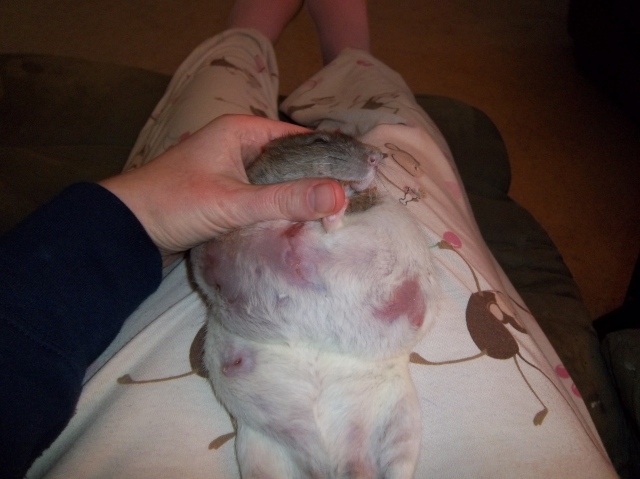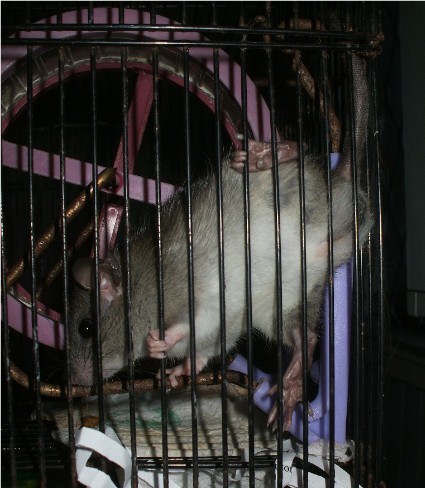QuestionI've had my boy Baley since the summer (he was a baby when
I got him) and I am considering getting a new rat.
Obviously I would be getting a male from a breeder and
quarantining and all that fun stuff.
My question is, what are the chances they will have
difficulties being introduced? Baley is very sociable, he
loves people, and he's met dogs and a chinchilla with
extreme interest.
Thanks
AnswerHi Kara
Chances are good. The only time meetings between two male rats fail is because we failed to do it properly, expected too much and lacked the proper amount of patience needed to do it right.
Here is a good article written by someone that knows alot about rats and she basically says the same things I would say as far as introducing rats:
*********************************
Introducing New Rats by Debbie Ducommun
****************
The willingness of rats to accept a new roommate depends on their personality and age. It will take more time--sometimes up to several weeks--to introduce a newcomer to adult rats, but it can be done. With time and patience, almost any rat will accept a newcomer.
The introduction process has several steps and the time required for each may vary. The easiest pairing will be two young rats, while the most difficult introduction is between two adult males, especially if they aren't neutered. On the other hand, as rats start to age they can mellow out and be more accepting of new roommates. A young rat is the best choice for a new roommate for an adult male, but the newcomer should be at least six weeks old. This is because adult males will sometimes kill strange baby rats younger than this.
When introducing rats, you should have two cages so the new rat can have his own cage at first. (The second cage can be the resident rat's travel cage.) Never just plop a new rat in the resident rats' cage because the residents will always defend their territory.
During the introduction process, you should only advance to the next step if there is no sign of aggression within 30 minutes. A resident rat will express aggression by puffing up his fur, arching his back, and swinging his body sideways at the newcomer. If you see this type of behavior, remove the new rat quickly to prevent an attack. Use care when picking up an aggressive rat as they will sometimes bite. Pick them up with a towel. Or if need to quickly break up a fight, you can pick up the aggressor by the base of his tail. If an introductory session results in aggression, try again later, or go back a step.
When introducing a new rat to a group of rats, usually only the dominant resident rat will be aggressive toward the newcomer at first. This is the dominant rat's "job". Once the new rat is accepted by the dominant rat, the others may show some aggression in turn, but it usually won't be as severe.
The Introduction Process
The first step is to place the cages near each other so the rats can see and smell each other. Place wire cages far enough apart so the rats can't reach through the bars to the other cage, or the result may be bitten toes or tail. The next step is to switch the rats to each other's cage, even briefly. This allows them first-hand experience with each other's scent. You may have to do this several times.
The next step is to introduce the rats in neutral territory, which should be someplace where the resident rats are not used to playing. The bathtub is a good place. This will give them a chance to become acquainted without the residents feeling the need to defend their territory. Another technique that can work is to take the rats for a car ride in a neutral carrier.
The next step is to let them interact in an area where the residents are used to playing. Watch them carefully, because this is where some fighting may break out. It may also help if you put the new rat(s) in your lap along with the other rats. By holding everyone at the same time, it may let the residents know that YOU have already accepted the new rat.
The final step is to clean the larger cage out completely and rearrange the furnishings so it appears to be a new cage. Trim the back toenails of the rats to minimize scratching in a scuffle. Put vanilla extract or perfume on all the rats to make them smell the same. Then put the rats in this cage. The best time to do this is in the morning when rats tend to be sleepy.
The dominant resident will probably sniff the newcomer and then "attack" him, forcing him over on his back. If you've followed the introduction process correctly, don't rush to take the new rat out. Instead, carefully observe the fight. Observe whether the resident rat is showing the raised hair, arched back, and sideways approach that are signs of aggression. If so, remove the newcomer, but if not, leave them together. The resident rat must establish his or her dominance and it's normal for them to "beat up" the newcomer. Just because the new rat is squeaking doesn't mean it's getting hurt. This is just a rat's way of saying "I give up". As long as you have followed the introduction process step by step, and as long as the resident rat isn't showing the signs of agression, you should let the fight run it's course. If you take the new rat out, you'll prolong this adjustment phase.
However, if it appears that the new rat is being injured, or if the attack seems especially vicious, then of course you should remove him from the cage. But in most cases the "fight" will be over quickly. The dominant resident rat will probably beat up the newcomer frequently for the first few days, and you shouldn't interfere as long as there are no injuries. But the first attack is usually the worst, and before long the rats will typically become the best of friends, sleeping together and grooming each other.
One of my members also suggested something that worked well for her. She smeared all her rats with pudding! After they got it all licked off each other, they had bonded! But this was a group of rats who had lived in the same house for a while, not brand new rats. You would still need to go through all they preliminary steps first.
Because rats are individuals with their own personalities, occasionally two rats will take a dislike to each other and constantly fight. In some cases, this means the pecking order is changing and the fighting will stop eventually. Neutering any males involved will usually solve the problem. (After a male is neutered, it can take up to 8 weeks for their behavior to change.) However, if these fights continue for more than several weeks, such rats should be separated permanently.
**************
Hope this helps!

 Advice on huge seroma
QuestionShelbys seroma
QUESTION: Hi Sandra,
My
Advice on huge seroma
QuestionShelbys seroma
QUESTION: Hi Sandra,
My
 follow up
QuestionUpsidedown Twitch
QUESTION: I found out
follow up
QuestionUpsidedown Twitch
QUESTION: I found out
 Rat fur in poor condition after hormonal implant
QuestionChiara and Luna
QUESTION: Hi Natasha I h
Rat fur in poor condition after hormonal implant
QuestionChiara and Luna
QUESTION: Hi Natasha I h
 my rat bigboy
QuestionQUESTION: hi my name is stuart i have a male ra
my rat bigboy
QuestionQUESTION: hi my name is stuart i have a male ra
 Rat is tearing fur and skin out - Post Op
QuestionCustard Wound Close Up
QUESTION: Hi,
I
Rat is tearing fur and skin out - Post Op
QuestionCustard Wound Close Up
QUESTION: Hi,
I